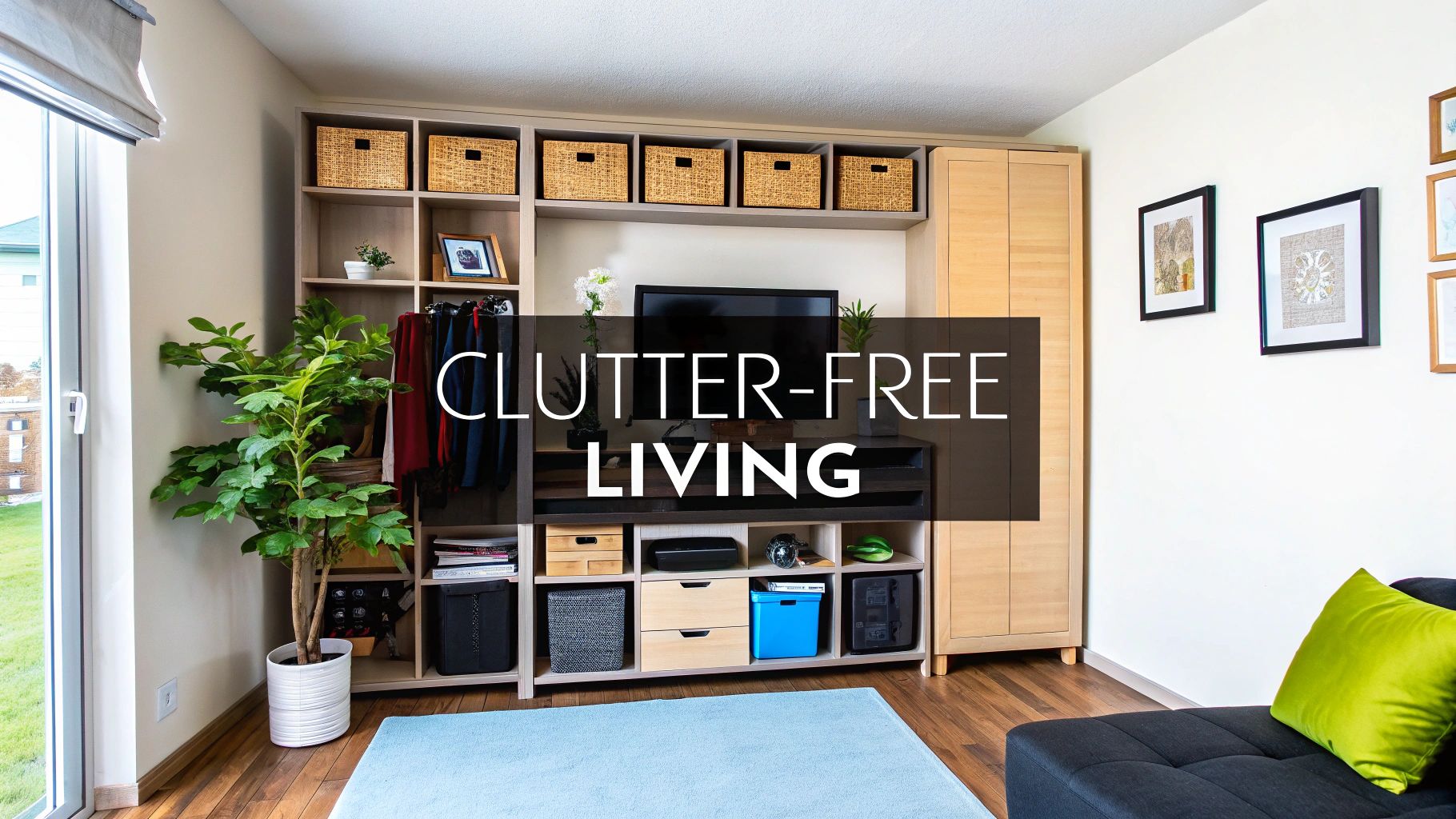
Feeling overwhelmed by a small living space is a universal problem. When every countertop is covered and every closet is bursting at the seams, it's easy to feel like the walls are closing in. But here’s the secret I’ve learned over years of helping people reclaim their homes: creating a sense of spaciousness has very little to do with actual square footage. It’s all about smart, intentional organization.
This isn't about tossing out everything you own or becoming a rigid minimalist. It’s about being realistic and making thoughtful decisions that fit your life right now. The real goal is to shape a home that feels open, works for you, and gives you a sense of calm—a place where everything has a purpose and a home.
The Secret to Living Large in a Small Home
I've found that the most successful approach to organizing any small space boils down to a simple, three-phase framework: Assess, Purge, and Maximize. Following this path turns a cluttered, stressful room into a functional, peaceful environment. You end up creating systems that work for you, not against you.
To make this feel less like a monumental task, let's look at this simple framework as your roadmap from chaos to calm. Each phase builds on the one before it, giving you a clear, logical path forward.
Your Roadmap to a Clutter-Free Life
Think of this as your game plan. First, you need to understand what you're working with.
- Assess: This is your reconnaissance mission. It's about taking a hard, honest look at your space and your habits. You'll pinpoint the problem zones—you know, that corner where things just seem to pile up—take inventory of what you actually have, and set realistic goals for each room.
- Purge: Now for the tough part. This is where you make the calls on what stays and what goes. I won't lie, it can be challenging, but it's also the most liberating step. It’s all about decluttering with intention.
- Maximize: Finally, the fun part! This is where you get clever with storage and layout. We'll get into using vertical space, finding furniture that does double duty, and other smart tricks to make every single inch count.
This little flowchart breaks it down visually, showing how organizing really just follows a simple sequence. You sort, you decide, and then you store everything systematically.
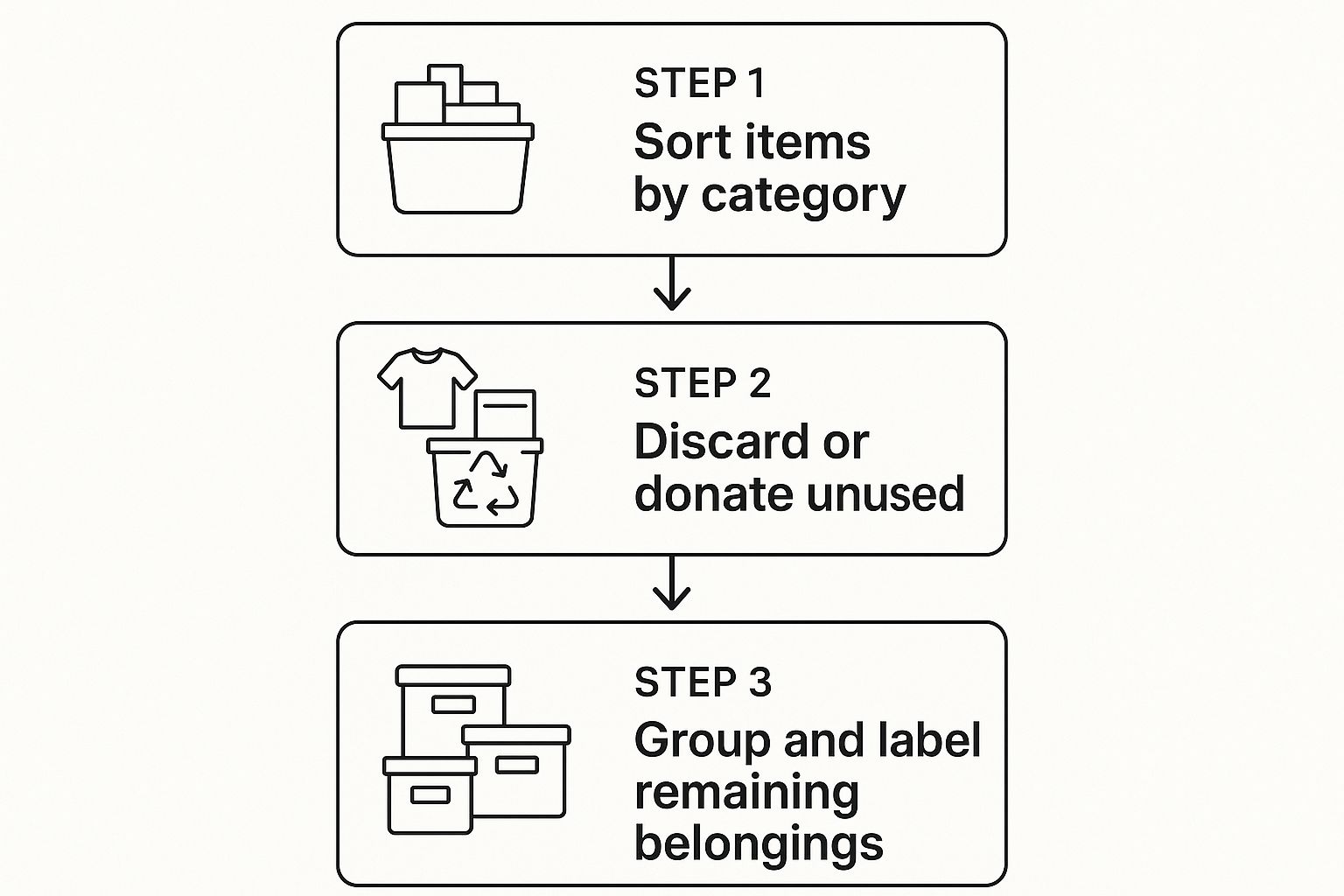
If you feel like you're the only one struggling, you're not. The professional organizing market is currently valued at around USD 2.1 billion and is expected to more than double by 2033. Why? Because nearly 68% of U.S. homes report having inadequate storage. It's a massive, shared challenge.
A lot of the best ideas for this come from studying tiny home living principles, where every single item must justify its existence.
To give you a clearer picture of the journey ahead, I’ve put together this quick overview. It lays out the entire process, so you know exactly what to expect.
The Three-Phase Framework for Small Space Organization
| Phase | Primary Goal | Key Activities |
|---|---|---|
| 1. Assess | Gain clarity and set a vision | Identify clutter hotspots, measure your space, and define your organizational goals. |
| 2. Purge | Ruthlessly eliminate non-essentials | Sort items into "Keep," "Donate," "Discard," and "Relocate" piles. Make firm decisions. |
| 3. Maximize | Optimize every square inch | Implement vertical storage, choose multi-functional furniture, and assign a "home" for every item. |
Seeing it laid out like this helps reinforce that there's a method to the madness. Stick to the phases, and you'll get there.
The real objective here isn't just to tidy up for a weekend. It's to create a sustainable system that makes your daily life simpler and less stressful. A well-organized small space gives you back your time and mental energy for the things that truly matter.
Reclaim Your Space with Practical Decluttering Methods
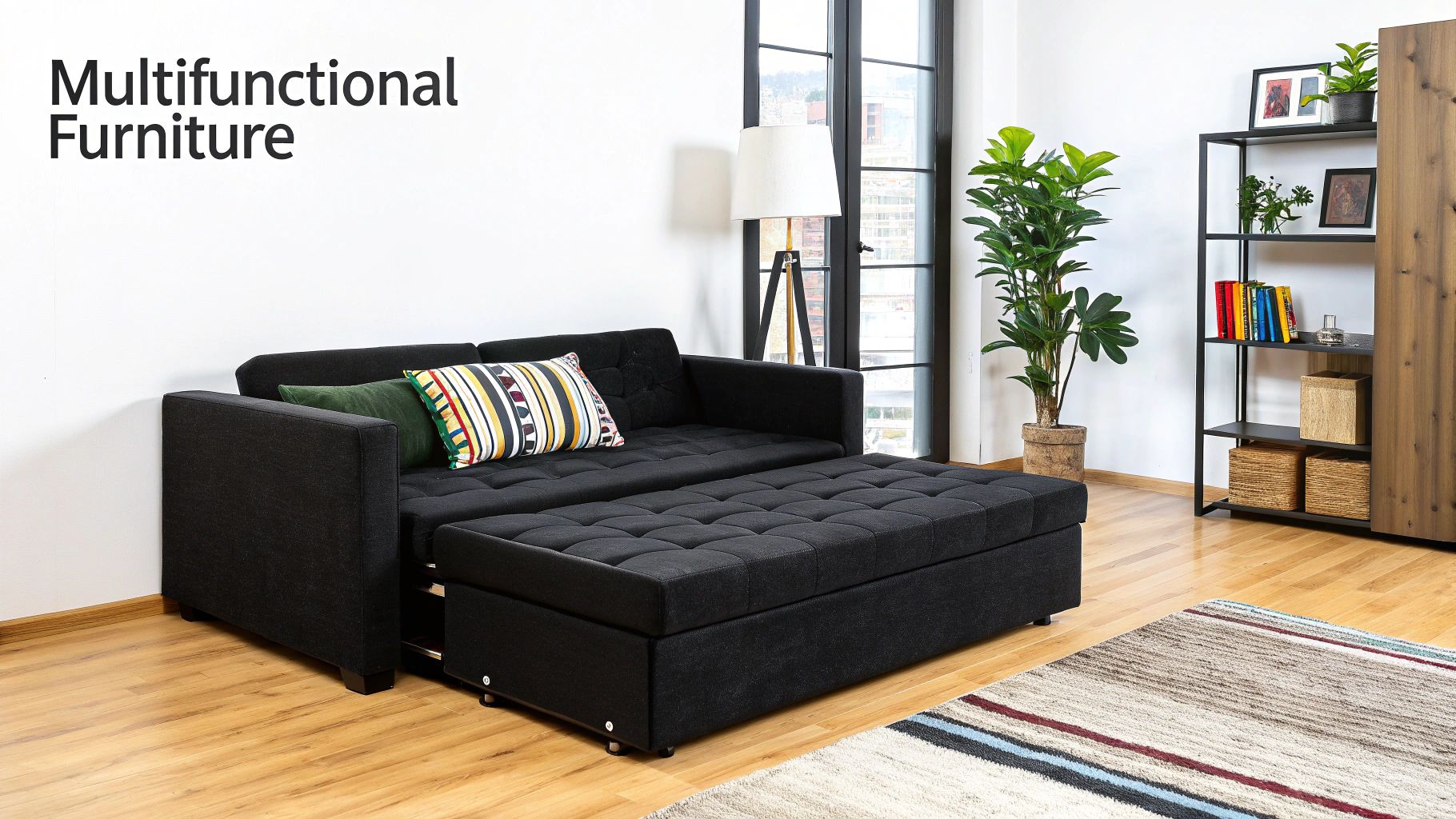
Alright, this is where the real work begins—and where the magic happens. Decluttering isn't about creating a sterile, empty house. It’s about making intentional choices to carve out a space that actually supports the life you're living right now. You’re taking back control from your stuff, one item at a time.
And you're not alone. The demand for a more organized life is booming. The home organization market was valued at around USD 8.5 billion last year and is expected to climb to USD 15.2 billion by 2032. This isn't surprising, especially with shrinking living spaces in cities forcing everyone to get smarter about their homes.
To get started, you need a system. Just jumping in without a plan often leads to shuffling piles from one room to another, which only makes the chaos worse.
The Four-Box Method for Purposeful Sorting
My absolute go-to strategy is the Four-Box Method. I love it because it’s simple and it forces a decision on every single item you pick up. No more waffling. Just grab four boxes (or make four distinct piles) and label them: Keep, Donate, Trash, and Relocate.
Here’s how it works in a real-world scenario, say, cleaning out a bookshelf:
- Keep: This is only for books you genuinely love or will absolutely read again. If you're keeping it, you have to know exactly where on the shelf it's going to live.
- Donate: That novel you finished and won't re-read? Or the cookbook you never opened? If it's in good shape, someone else will appreciate it. My rule of thumb: if you haven't touched it in a year, it's time to let it go.
- Trash: This one’s for the ripped paperbacks, the outdated manuals, and anything broken or unusable. Don’t pass your trash on to a charity.
- Relocate: This is the "why is this even here?" box. It’s for the screwdriver that belongs in the garage or the stack of mail that needs to go to your desk.
This method completely eliminates that dreaded "I'll deal with this later" pile. Once you’re done, you have clear next steps: put away the Keep and Relocate items, take out the trash, and drop off the donations.
A word of warning: don't let the 'Relocate' box become a new doom-box. The goal is to empty it completely by the end of your session. Put everything back where it belongs immediately.
Tackling High-Clutter Zones
Every home has them. Those spots where clutter seems to breed overnight. For most of us, that's the closet and the kitchen. If you can apply a focused strategy here, you’ll see big results fast, which is a huge motivator.
When you’re staring down your closet, get brutally honest. Ask these questions for every piece of clothing:
- Have I worn this in the last year?
- Does it fit me right now and make me feel good?
- If I saw this in a store today, would I buy it again?
If you hesitate or answer "no" to any of these, it goes straight into the Donate box.
The kitchen needs the same tough love. Check expiration dates on everything in the pantry. Get rid of duplicate gadgets—I mean, does anyone really need three vegetable peelers or an entire cabinet of mismatched coffee mugs? Probably not.
Navigating the Emotional Side of Decluttering
Let's be real, sometimes the hardest things to get rid of have no practical value at all. They're the sentimental items. The things tied to memories, people, and past versions of ourselves. They feel heavy because they are heavy with emotion.
When you pick up a sentimental item, give yourself a moment. It's okay to feel that pang of nostalgia. Then, ask yourself if the memory is truly in the object, or if it lives in your heart and mind. More often than not, you can honor the memory without keeping the physical thing. We talk more about this in our guide on how to declutter your home.
Here are a few compassionate ways to handle these items:
- Take a Picture: Snap a photo of your grandmother's tea set or your child's first art project. Create a digital album of these keepsakes. You get the memory without sacrificing the shelf space.
- Keep a Small Sample: You don't need all 50 of your college T-shirts. Pick one or two favorites and let the rest go. Same with a box of old letters—choose a few that mean the most.
- Create a Memory Box: This is a game-changer. Get one—and only one—reasonably sized box for your absolute most-treasured keepsakes. Once it’s full, the rule is one-in, one-out.
This isn’t about erasing your past. It’s about curating it, so the things you keep are truly special and don't overwhelm the space you need for your life today. By making these thoughtful choices, you're designing a home that feels calm, functional, and completely, wonderfully yours.
Find Smart Storage for Every Small Space
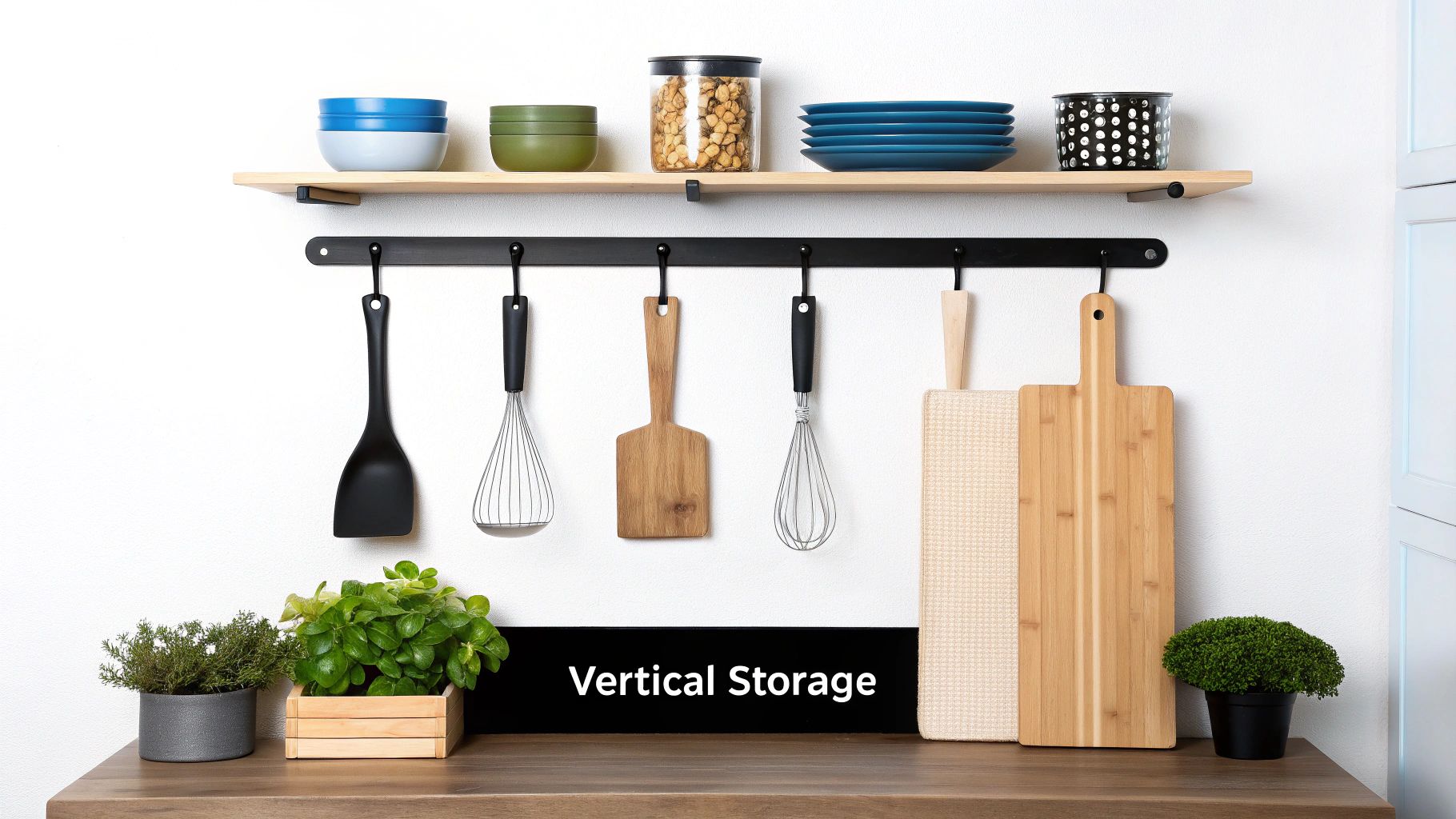
Okay, you’ve decluttered. Now for the fun part: getting creative with storage. This isn't about just finding places to hide your stuff. It's about turning your home into a clever, functional space where everything has a home. Think of it as a strategic puzzle—transforming overlooked nooks and bare walls into your greatest organizational assets.
It’s no surprise that clever storage is a hot topic. The global home storage market was valued at a staggering USD 46 billion last year and is only getting bigger. As more of us live in smaller, urban spaces, we're all forced to get smarter about how we use the room we have.
The right storage is what keeps a space from reverting to chaos. Let's get into the practical ways you can make it happen without sacrificing an ounce of style.
Go Vertical and Reclaim Your Floor Space
In most small homes, the most neglected real estate is the wall space above our heads. When you start thinking vertically, you not only unlock tons of storage potential but also create an illusion of height, making the entire room feel more spacious and open.
Forget clunky, floor-hogging bookcases. Floating shelves are a game-changer for displaying photos, plants, and books without any of the bulk. In the kitchen, imagine freeing up an entire drawer by installing a wall-mounted pot rack or a sleek magnetic knife strip. The same goes for the bathroom—a few simple shelves above the toilet create the perfect spot for towels and toiletries.
- Floating Shelves: Perfect for living rooms and bedrooms. They give you a place for your favorite things without eating up precious floor space.
- Hanging Organizers: An over-the-door shoe organizer is surprisingly versatile. Use it in the pantry for snacks, in a closet for cleaning supplies, or for corralling craft items.
- Pegboards: These aren't just for garages anymore. A pegboard in a home office or craft room gives you completely customizable, easy-to-reach storage for all your tools and supplies.
The goal here is simple: get things off the floor and countertops. Every item you can hang on a wall or place on a shelf is a small victory for a clutter-free home.
Choose Furniture That Works Smarter
When you're tight on space, every single piece of furniture needs to pull its weight. Single-purpose items are a luxury most small spaces can't afford. The key is to seek out multi-functional pieces that cleverly combine style with hidden storage.
This is where you can really make your furniture work for you. A storage ottoman is a classic for a reason—it hides blankets and board games while serving as a footrest or extra seating. A lift-top coffee table is another hero, instantly transforming into a workspace while keeping remotes and magazines neatly tucked away.
Don't overlook your bed, either. It’s a huge piece of furniture, and the space underneath is pure gold. Look for frames with built-in drawers or simply slide in some wheeled containers. It's the ideal spot for stashing out-of-season clothes, extra linens, or shoes, keeping them accessible but completely out of sight.
Maximize Your Hidden Spaces
Every home, no matter its size, is full of awkward nooks and crannies just begging to be put to use. You just have to train your eye to spot them.
Kitchen cabinets are a great place to start. That empty space above your stacks of plates or canned goods? A simple wire under-shelf basket can instantly double your storage for spice jars, tea boxes, or mugs. You can find more ideas for https://findtoptrends.com/blogs/news/space-saving-kitchen-tools to completely change how your kitchen functions.
And don't forget about the inside of cabinet doors! It's the perfect spot for small adhesive caddies to hold sponges under the sink or for racks to organize pot lids and cutting boards. Once you start thinking about these "micro-spaces," you’ll see opportunities everywhere. If you're using off-site storage to help, make sure you avoid common storage unit mistakes so your items stay safe and easy to find.
Comparing Popular Small Space Storage Solutions
With so many options out there, it can be tough to figure out what will actually work for your home and your life. This little breakdown compares some of the most popular solutions I recommend to clients.
| Storage Solution | Best For | Pros | Cons |
|---|---|---|---|
| Vertical Shelving | Using bare walls for books, decor, or kitchen gear. | Gets things off the floor; makes rooms feel taller. | Needs to be installed; can look messy if not styled well. |
| Multi-Functional Furniture | Living rooms, studio apartments, and bedrooms. | Does two jobs in one; brilliantly hides clutter. | Often pricier; storage capacity can be limited. |
| Under-Bed Storage | Tucking away seasonal clothes, shoes, or extra linens. | Uses otherwise wasted space; keeps items out of sight. | Can be a dust magnet; might have to move the mattress. |
| Over-the-Door Organizers | Bathrooms, closets, and pantries. | Super affordable and versatile; no installation needed. | Can keep doors from closing properly; not great for heavy items. |
Ultimately, finding the right storage is a personal journey. It all comes down to your space, your budget, and what you need to store. By mixing these strategies—going vertical, choosing smart furniture, and unlocking hidden nooks—you can build a system that makes your small space feel organized, intentional, and so much bigger.
2. Create Openness with Strategic Furniture Layouts
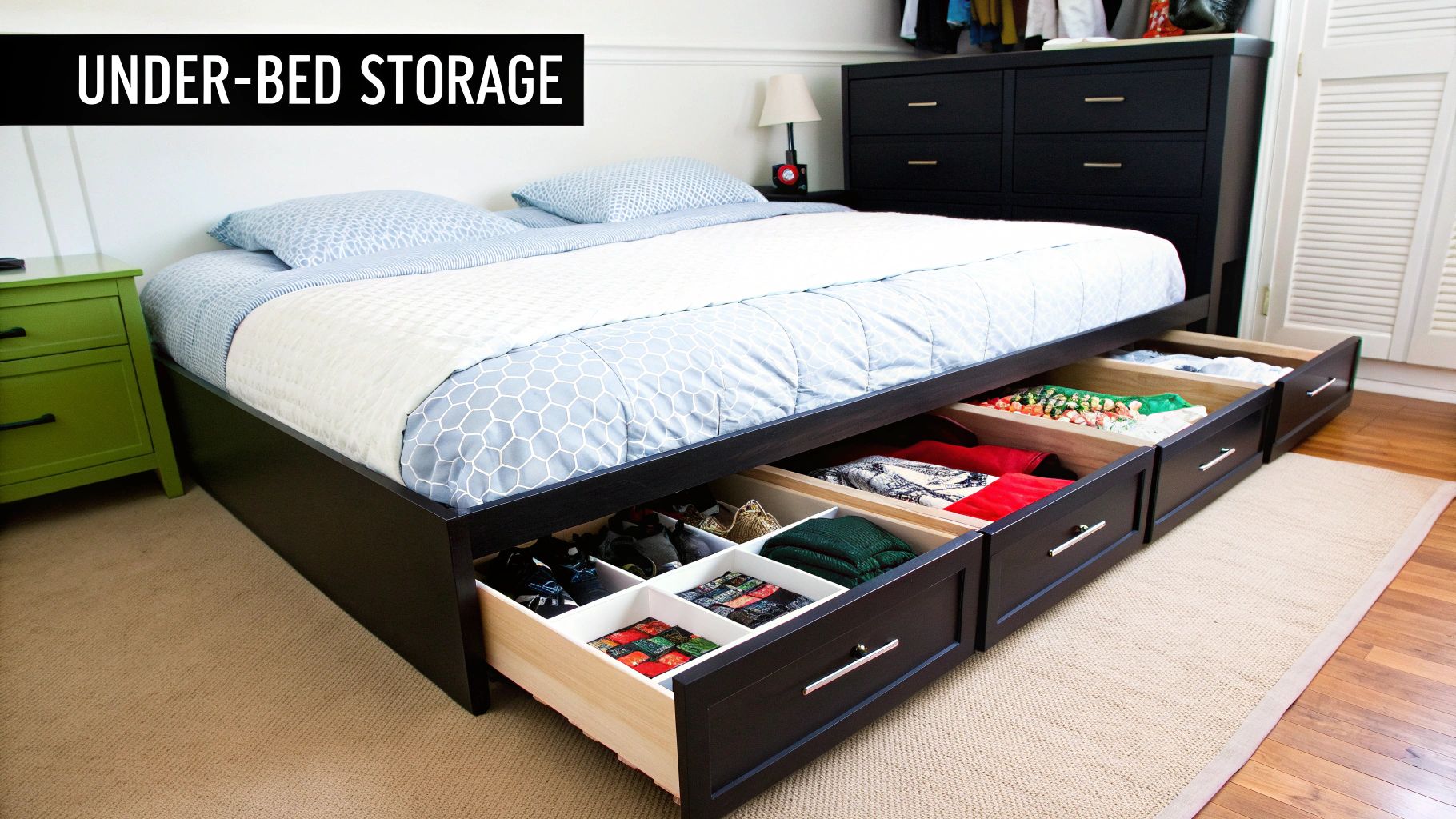
Alright, you’ve decluttered and your storage is working smarter, not harder. Now for the fun part: arranging your furniture. How you place your furniture can make or break a small room, single-handedly deciding if it feels cramped or surprisingly open. This isn't about getting rid of things; it's about placing what you own with purpose.
Getting the layout right is one of the most powerful tricks I know when it comes to how to organize small spaces. It’s all about creating a natural flow, letting in as much light as possible, and playing a few visual tricks to make the room feel bigger than its actual footprint.
Embrace Flow and "Negative Space"
First things first: you need clear pathways. You should be able to walk from one end of the room to the other without doing a slalom around ottomans and side tables. This easy flow doesn’t just make the space easier to live in—it also brings a sense of calm and order.
Here’s a tip that sounds wrong but works every time: pull your furniture away from the walls. I know, it feels like you're wasting precious space, but even just a few inches between your sofa and the wall creates an illusion of depth that makes the whole room breathe. It’s the perfect antidote to that long, narrow "bowling alley" look many rooms suffer from.
That empty space around your furniture—what designers call negative space—is just as important as the furniture itself. It gives your eyes a place to rest and keeps the room from feeling heavy and overstuffed.
Choose Furniture That Creates an Illusion of Space
The "visual weight" of your furniture has a huge impact on how spacious a room feels. Bulky, solid pieces that sit flat on the floor can make a room feel weighed down and claustrophobic. The fix? Choose furniture that looks and feels lighter.
My go-to recommendation is to look for pieces with legs. Think of a mid-century modern sofa or a console table on slender supports. By lifting furniture off the ground, you let light flow underneath and you can see more of the floor, which instantly makes the room feel more open and airy.
Here are a few other furniture tricks I’ve picked up over the years:
- Go Transparent: A glass coffee table or clear acrylic chairs are game-changers. They’re practically invisible, doing their job without blocking your line of sight. It's a simple way to maintain that open feeling.
- Soften the Edges: Furniture with soft, rounded edges tends to work better in small spaces than sharp, boxy pieces. Curves are easier to move around and just feel less imposing when you’re in a tight spot.
- Get the Scale Right: Be honest with yourself about furniture size. That giant, super-comfy sectional might seem like a great idea, but if it eats your entire living room, it's not the right fit. Always choose pieces that are proportional to your room.
Use "Zoning" to Define Different Areas
In most small homes, a single room often has to wear many hats. Your living room might also be your dining room and your home office. The secret to preventing this from becoming one chaotic mess is zoning.
Zoning is simply using visual cues to create distinct “zones” for different activities within one open space. It’s an old interior design trick that brings a ton of order to multipurpose rooms. And you can do it with just a few simple tools.
Rugs are the easiest way to create a zone. For example, an area rug placed under your sofa, chairs, and coffee table instantly carves out a dedicated living room space, visually separating it from everything else.
Lighting is another great tool for zoning. A cool pendant light hanging over a small table clearly says, "this is the dining spot." A floor lamp tucked beside an armchair creates a dedicated reading nook. By defining areas by function, you bring a logical order to the room that walls never could.
Build Lasting Habits to Maintain Your Organized Home
You’ve done it. You've decluttered, sorted, and wrestled your small space into a state of calm. But now comes the real test: keeping it that way. The truth is, organization isn't a one-and-done project. It's an ongoing practice, a collection of small, almost effortless habits that keep the clutter from creeping back in.
Learning how to organize small spaces for the long haul is all about creating simple systems that feel like second nature, not a chore. These routines are the secret sauce that keeps chaos at bay.
Integrate Simple Daily Routines
The real magic to a consistently tidy home is weaving organization into the fabric of your day. This isn't about deep cleaning every night. It's about tiny, consistent actions that take almost no time but pay off big.
One of my favorite tricks is the '10-Minute Tidy' before bed. I just set a timer and do a quick sweep of the living room. Fluffing pillows, putting away the remote, wiping down the kitchen counter—it’s amazing what you can get done in just ten minutes. Waking up to a reset space is a much better way to start the day.
Another game-changer is the 'One-Touch Rule'. It sounds simple, but it's incredibly powerful. The idea is to deal with an item the moment you touch it, instead of setting it down to handle "later."
- Mail doesn't hit the counter; it gets opened over the recycling bin, and the important stuff gets filed immediately.
- Your coat doesn't get draped over a chair; it goes straight into the closet.
- That dirty dish? Rinse it and put it right into the dishwasher instead of letting it sit in the sink.
This one habit single-handedly prevents those "doom piles" of postponed decisions from ever forming.
Establish a Weekly Reset Day
While daily touch-ups handle the surface stuff, a weekly reset is your chance to hit the refresh button on your whole system. I usually pick a time on Sunday to spend 30-60 minutes putting everything fully back in its place. This isn't a deep clean; it's just maintenance.
My weekly reset usually involves:
- The Great Return: I'll grab a basket and walk through the apartment, collecting anything that’s wandered away from its home and putting it back.
- Surface Sweep: Completely clear and wipe down countertops, the coffee table, and my desk. A clear surface just feels more peaceful.
- Hotspot Attack: I spend ten minutes on one known problem area, like the entryway console or that one kitchen drawer that always gets messy.
This little ritual guarantees that no matter how hectic the week gets, order is never more than a few days away.
Think of it like this: daily tidies are like brushing your teeth, while the weekly reset is like flossing. Both are essential, and skipping them will absolutely cause bigger problems down the line.
Combat Clutter at the Source
Honestly, the most effective way to stay organized is to stop clutter before it even crosses your threshold. It’s all about being more mindful of what you allow into your home.
A great rule to live by is the 'One-In, One-Out' rule, especially for things like clothes, books, and kitchen tools. Before you bring home a new sweater, you have to decide which old one is leaving. It really makes you question if a new purchase is worth the space it will occupy. This is also key for keeping your kitchen from overflowing. Before buying another gadget, ask yourself if you could streamline your toolkit with a few well-chosen, space-saving compact kitchen appliances instead.
Get ruthless with paper. Put a recycling bin right by the door and immediately toss junk mail, flyers, and catalogs. For the papers you do need to keep, give them a single, designated home. By creating these simple barriers, you build a powerful defense against the daily flood of potential clutter, making it so much easier to keep the peace.
Got Questions? Let's Troubleshoot Your Toughest Small-Space Challenges
Even with a solid plan, you're bound to hit a few snags when organizing a small home. It happens to everyone. Let's walk through some of the most common questions I get asked, with practical answers to get you over those hurdles.
I'm So Overwhelmed—Where Do I Even Begin?
That feeling of being completely swamped is the biggest reason organizing projects stall before they even start. The secret? Stop thinking big. I mean, think really small. Forget about tackling the whole apartment this weekend.
Instead, pick one tiny, almost laughably small area. I’m not talking about a room. I’m talking about the junk drawer in your kitchen. One shelf of your bookcase. The pile of mail on the entryway table. Set a timer for just 15 minutes and give that one spot your full attention.
Finishing that small task creates a little spark of momentum. It proves you can do it, which makes the next small task feel that much easier.
The goal isn't to achieve perfection overnight. It's about making consistent, steady progress. A bunch of small wins will always beat one giant, overwhelming plan that you never actually start.
What Do I Do with Sentimental Things I Just Can't Let Go Of?
This is a big one. Sentimental items are so much more than just stuff; they're tied directly to our memories and emotions. The trick is to honor the memory without letting the object become a burden. You don't have to discard everything that means something to you.
First, ask yourself if there's another way to preserve the memory. Sometimes, taking a beautiful, high-quality photo of an item before you donate it can be surprisingly liberating. You get to keep the memory without sacrificing precious shelf space.
For the physical items you truly need to keep, it’s all about curating them.
- Create a dedicated memory box. This is the one designated spot for your most cherished keepsakes. When it’s full, you have to adopt a "one-in, one-out" policy.
- Put them on display. Why keep your grandmother's beautiful teacups in a dusty box? Use them as tiny planters for succulents on a windowsill. Have a pile of old concert t-shirts? Turn them into a cool quilt or a few throw pillows.
This shifts your mindset from hoarding sentimental "clutter" to showcasing a meaningful collection that brings you joy.
How Do I Stay Organized with Kids or a Messy Partner?
Trying to maintain order in a shared home can feel like an uphill battle, especially when you feel like you're the only one trying. Success here depends on creating systems that are so simple, it’s actually easier for everyone to use them than to make a mess.
Everything needs a clear, designated "home," and labels are your best friend. For little kids who can't read yet, use picture labels so they know exactly where the blocks or dolls belong. Place hampers, toy bins, and baskets right where the clutter happens, not just where they look aesthetically pleasing.
For instance, if jackets and backpacks always end up in a heap by the door, install a few low hooks that even a small child can reach. If your partner’s papers constantly take over the kitchen counter, set up a simple "inbox" tray where they can drop everything to sort through later. It’s not about changing people’s habits overnight, but about building simple, easy-to-use systems that work with them.
Ready to discover the perfect items to maximize your home? FindTopTrends curates the best space-saving furniture, clever organizers, and trending home essentials to make your life easier. Shop our collections today and transform your space.










